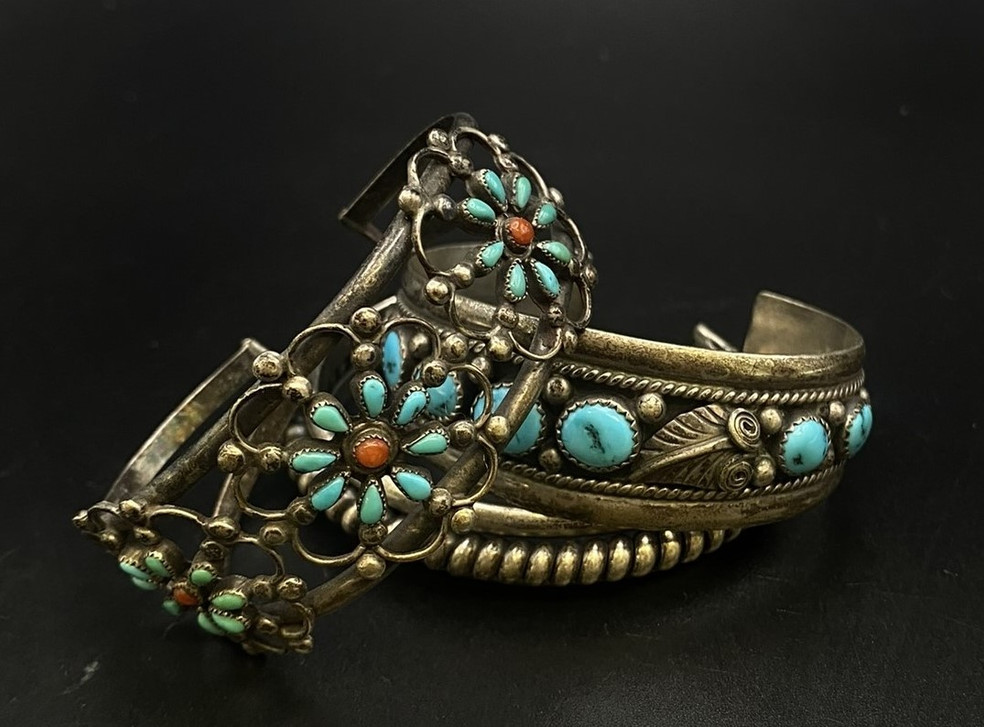Some examples of the beautiful jewelry designs of Native American artist.
Cluster- A cluster is a close arrangement of stones. Native American artists freely place similarly sized and shaped stones in a linear or non-linear fashion to form eye-catching pieces. In unorganized arrangements these stones don’t necessarily match one another exactly; in fact, it’s just as common for a Native American jewelry cluster design to be an unorganized cluster with stones that do not match exactly as it is for them to be arranged.
Concha or Concho- A round or oval silver ornament derived from the hair pieces of the Plains Indians and adapted by the Navajos to be added to belts, horse tack, and other items. Often a hole is cut in the center with a bar left across the opening to string it on a belt or leather strap. When Turquoise became more popular the conchos were adapted to have a Chicago screw type back. Traditionally conchos have scalloped edges, some stamping, and a border with a rope design.
Fetish- a small object believed to have magical powers.
Heshe- Small Turquoise (or shell) disc shaped beads, flat on the top and bottom, and with a hole drilled through the middle. Turquoise disc beads have been made by the Santo Domingans for centuries. Usually strung in single or multi-strand bead necklaces with silver, shell, jet, and/or coral. Some beads are very tiny.
Inlay- This style incorporates flattened stones that are measured, cut, shaped, and carefully laid in place to create a design. The Zuni tribe is known for mastering this style of art. The different types of Native American inlay jewelry are categorized by how the stones are held in place, for example, through channel inlay or stone to stone inlay. In channel work a base is made and a narrow rim soldered around it. Dividers are fitted and soldered inside. This is tedious work and requires skill. Turquoise, shell, coral and other stones are then fitted and usually glued into these “channels”, slightly lower than the edge and the edges are folded in slightly to hold the stones.
Jacloh- Loops of Turquoise beads about 5 to 6 inches long, that are worn as earrings or include in disc or shell bead necklaces or worn on chain necklaces as a pendant.
Kachina- Small Kachinas are often used in jewelry, it is a Zuni ceremonial figure.
Naja- A crescent shaped ornament usually a pendant worn on a chain. The shape is used often, but it is believed the Native Americans do not have a particular symbolism for it. The Native Americans got it from the Spaniards, who used it extensively for their horse tack.
Overlay- The Hopi tribe is best known for mastering geometric patterned overlay jewelry. The overlay style is made of two or more metals that are overlaid, one on top of another. The bottom strip of metal is darkened through tempering, scratching or chemically oxidizing. The depth of each layer creates dimension in the design. Usually, shapes are cut into a strip which is then layered on a solid strip for a 3-dimensional look.
Squash Blossom- Squash Blossoms are by all groups of Native Americans in necklaces, earrings and bolo ties. The design was originally adapted by Native Americans form shapes that the Mexicans used as decoration on their pants seams. The shape is actually said to resemble a pomegranate blossom. The Navajos’ squash blossoms are usually large, featuring beautiful silverwork and maybe a modest amount of Turquoise. The Zunis use a lot less silver and a lot more Turquoise.
Stamping- Stamping is anther technique used often in Native American jewelry and silverwork, that was acquired form the Mexicans. Stamping is done by using a stamp, made from a hardened steel punch or die, and tapping it on the silver to imprint a design. Many believe these stamps have symbolism to the Native Americans, but most likely the Native Americans traded for the stamps from the Mexicans or designed their own with designs they liked. It is a skill to learn exactly how hard to hit the stamp to get a good impression.
Please note: The Indian Arts and Crafts Act (IACA) of 1990 says that art and craftwork made after 1935 can only be marketed as “Indian,” “Native American,” or “Alaska Native,” or product of a particular Indian Tribe if it’s made by a member of a Tribe that is federally recognized or officially recognized by a state, or an individual who has been certified as a non-member Indian artisan by the Tribe.
You, of course, can try some of the techniques Native Americans use, you can even sell your own jewelry, but please don’t label your jewelry as Native American made if it isn’t!
Please check out my last month’s blog:
 US Dollar
US Dollar
 Australian Dollar
Australian Dollar
 Euro
Euro
 Canadian Dollar
Canadian Dollar
 British Pound Sterling
British Pound Sterling

